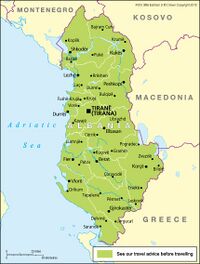Ceraunian Mountains
| Author:Laxman Burdak, IFS (Retd.) |

Ceraunian Mountains are a coastal mountain range in southwestern Albania, within the county of Vlorë.
Variants
- Ceraunian
- Ceraunian mountains
- Albanian: Malet e Vetëtimës,[1]
- Thunderbolt mountains
- Greek: Κεραύνια Όρη, Keravnia ori
- Latin: Cerauni Montes)
- Akroceraunian Mountains (Ancient Greek: Ἀκροκεραύνια, Albanian: Malet Akrokeraune[2])
- Ceraunia
Jat Gotras Namesake
Location
The range rises on the northeastern bank of the Ionian Sea. It extends for approximately 100 km in a southeast-northwest direction near Sarandë along the Albanian Riviera nearby to Orikum. Geologically, the Karaburun Peninsula belongs to the mountain range, forming the eastern Akroceraunian Mountains. The mountains are about 24 km long and about 4–7 km wide.[3]
Name
The name Ceraunia is derived from Ancient Greek Κεραύνια ὄρη,[4][5] meaning "thunder-split peaks"[6] and illustrates the bad weather and the danger found there by ancient seafarers and travellers.[7]
History
The Ceraunian mountain range is located in the northernmost part of the wider historical and geographical region of Epirus.[8]According to Greek mythology, the Abantes from Euboea who had previously joined the Ancient Greek army in the Trojan War settled in the Ceraunian Mountains. They were later expelled by the forces of the Ancient Greek city-state of Apollonia.[9]
The Ceraunian Mountains have been described by ancient writers such as Ptolemy, Strabo and Pausanias. Consequently, the mountains are still known under their classical name. Julius Caesar first set foot on Llogara Pass and rested his legion at Palasë on the Ionian coast during his pursuit of Pompey.
Mention by Pliny
Pliny[10] mentions Lake Mieotis and the adjoining nations.... There are some writers who state that there are the following nations dwelling around the Mæotis, as far as the Ceraunian mountains;13 at a short distance from the shore, the Napitæ, and beyond them, the Essedones, who join up to the Colchians, and dwell upon the summits of the mountains:
13 The Ceraunian mountains were a range belonging to the Caucasian chain, and situate at its eastern extremity; the relation of this range to the chain has been variously stated by the different writers.
Mention by Pliny
Pliny [11] mentions Albania, Iberia, and The Adjoining Nations...... Beyond these8 (Paryadres) are the deserts of Colchios, on the side of which that looks towards the Ceraunian Mountains dwell the Armenochalybes9; and there is the country of the Moschi, extending to the river Iberus, which flows into the Cyrus; below them are the Sacassani, and after them the Macrones, upon the river Absarus.
8 To the west.
9 "The Armenian workers in iron," or "Chalybes of Armenia." See p. 9.
References
- ↑ Basha, Nermin (2012). "Epiri dhe Botailire ne veprën e Jul Cezarit, "Mbi Luftën Civile" [Epirus and the Illyrian world in the work of Julius Cesar, "On the Civil War"]". Studime Historike (3–4): 5–25. "malet Akrokeraune, sot Malet e Vetëtimës"
- ↑ Basha, Nermin (2012). "Epiri dhe Botailire ne veprën e Jul Cezarit, "Mbi Luftën Civile" [Epirus and the Illyrian world in the work of Julius Cesar, "On the Civil War"]". Studime Historike (3–4): 5–25. "malet Akrokeraune, sot Malet e Vetëtimës"
- ↑ "Management Plan Llogora-Rreza e Kanalit-Dukat -Orikum-TragjasRadhime-Karaburun Complex Site" (PDF). vinc.s.free.fr (in Albanian). p. 23.
- ↑ Strabo, Geography, Book VI, 3.5 at LacusCurtius
- ↑ Strabo, Geography Book VII, 5.1 LacusCurtius
- ↑ Keraunia Archived December 2, 2009, at the Wayback Machine, Henry George Liddell, Robert Scott, A Greek-English Lexicon, at Perseus
- ↑ Morton, Jamie (18 September 2017). The Role of the Physical Environment in Ancient Greek Seafaring. BRILL. p. 77. ISBN 978-90-04-35107-3.
- ↑ Shrimpton, Gordon S. (1991). [9780773562912 Theopompus the historian]. McGill-Queen's University Press. p. 391.
- ↑ Joaquim Carvalho. Religion, Ritual and Mythology: Aspects of Identity Formation in Europe, Pisa University Press, p. 148
- ↑ Natural History by Pliny Book VI/Chapter 7
- ↑ Natural History by Pliny Book VI/Chapter 11

